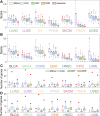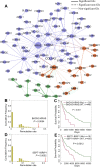Individualized genetic network analysis reveals new therapeutic vulnerabilities in 6,700 cancer genomes
- PMID: 32101536
- PMCID: PMC7062285
- DOI: 10.1371/journal.pcbi.1007701
Individualized genetic network analysis reveals new therapeutic vulnerabilities in 6,700 cancer genomes
Abstract
Tumor-specific genomic alterations allow systematic identification of genetic interactions that promote tumorigenesis and tumor vulnerabilities, offering novel strategies for development of targeted therapies for individual patients. We develop an Individualized Network-based Co-Mutation (INCM) methodology by inspecting over 2.5 million nonsynonymous somatic mutations derived from 6,789 tumor exomes across 14 cancer types from The Cancer Genome Atlas. Our INCM analysis reveals a higher genetic interaction burden on the significantly mutated genes, experimentally validated cancer genes, chromosome regulatory factors, and DNA damage repair genes, as compared to human pan-cancer essential genes identified by CRISPR-Cas9 screenings on 324 cancer cell lines. We find that genes involved in the cancer type-specific genetic subnetworks identified by INCM are significantly enriched in established cancer pathways, and the INCM-inferred putative genetic interactions are correlated with patient survival. By analyzing drug pharmacogenomics profiles from the Genomics of Drug Sensitivity in Cancer database, we show that the network-predicted putative genetic interactions (e.g., BRCA2-TP53) are significantly correlated with sensitivity/resistance of multiple therapeutic agents. We experimentally validated that afatinib has the strongest cytotoxic activity on BT474 (IC50 = 55.5 nM, BRCA2 and TP53 co-mutant) compared to MCF7 (IC50 = 7.7 μM, both BRCA2 and TP53 wild type) and MDA-MB-231 (IC50 = 7.9 μM, BRCA2 wild type but TP53 mutant). Finally, drug-target network analysis reveals several potential druggable genetic interactions by targeting tumor vulnerabilities. This study offers a powerful network-based methodology for identification of candidate therapeutic pathways that target tumor vulnerabilities and prioritization of potential pharmacogenomics biomarkers for development of personalized cancer medicine.
Conflict of interest statement
The authors declare no competing financial interest.
Figures






Similar articles
-
Structure-Based Analysis Reveals Cancer Missense Mutations Target Protein Interaction Interfaces.PLoS One. 2016 Apr 4;11(4):e0152929. doi: 10.1371/journal.pone.0152929. eCollection 2016. PLoS One. 2016. PMID: 27043210 Free PMC article.
-
Molecular analysis of urothelial cancer cell lines for modeling tumor biology and drug response.Oncogene. 2017 Jan 5;36(1):35-46. doi: 10.1038/onc.2016.172. Epub 2016 Jun 6. Oncogene. 2017. PMID: 27270441 Free PMC article.
-
TP53 mutations, expression and interaction networks in human cancers.Oncotarget. 2017 Jan 3;8(1):624-643. doi: 10.18632/oncotarget.13483. Oncotarget. 2017. PMID: 27880943 Free PMC article.
-
New tools for old drugs: Functional genetic screens to optimize current chemotherapy.Drug Resist Updat. 2018 Jan;36:30-46. doi: 10.1016/j.drup.2018.01.001. Epub 2018 Jan 12. Drug Resist Updat. 2018. PMID: 29499836 Free PMC article. Review.
-
Whole-exome sequencing reveals recurrent somatic mutation networks in cancer.Cancer Lett. 2013 Nov 1;340(2):270-6. doi: 10.1016/j.canlet.2012.11.002. Epub 2012 Nov 12. Cancer Lett. 2013. PMID: 23153794 Review.
Cited by
-
A new vulnerability to BET inhibition due to enhanced autophagy in BRCA2 deficient pancreatic cancer.Cell Death Dis. 2023 Sep 21;14(9):620. doi: 10.1038/s41419-023-06145-9. Cell Death Dis. 2023. PMID: 37735513 Free PMC article.
-
Familial Pancreatic Cancer Research: Bridging Gaps in Basic Research and Clinical Application.Biomolecules. 2024 Oct 30;14(11):1381. doi: 10.3390/biom14111381. Biomolecules. 2024. PMID: 39595558 Free PMC article. Review.
-
Nucleotide-based genetic networks: Methods and applications.J Biosci. 2022;47(4):63. doi: 10.1007/s12038-022-00290-7. J Biosci. 2022. PMID: 36226367 Free PMC article.
-
NESM: a network embedding method for tumor stratification by integrating multi-omics data.G3 (Bethesda). 2022 Nov 4;12(11):jkac243. doi: 10.1093/g3journal/jkac243. G3 (Bethesda). 2022. PMID: 36124952 Free PMC article.
-
Analysis of immune cell infiltration in the tumor microenvironment of cervical cancer and its impact on immunotherapy.Front Oncol. 2025 Jul 3;15:1608597. doi: 10.3389/fonc.2025.1608597. eCollection 2025. Front Oncol. 2025. PMID: 40678068 Free PMC article.
References
Publication types
MeSH terms
Substances
Grants and funding
LinkOut - more resources
Full Text Sources
Medical
Research Materials
Miscellaneous

